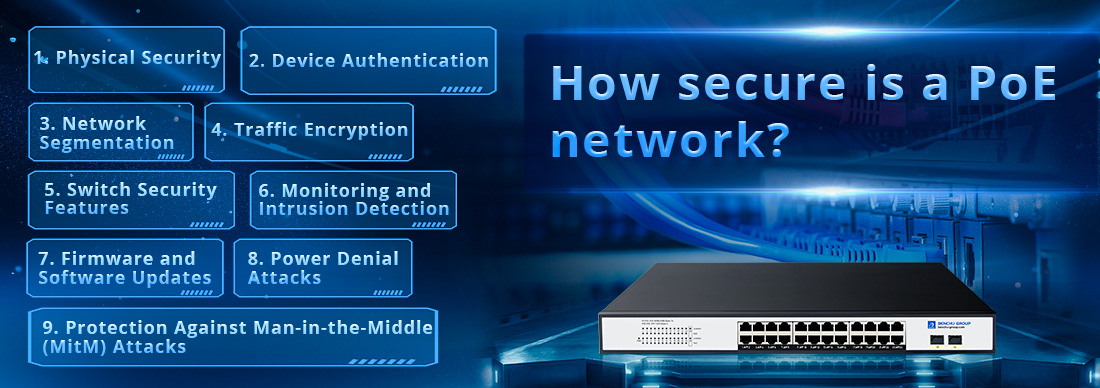
A Power over Ethernet (PoE) network can be very secure when properly designed and managed. While PoE itself is focused on delivering power along with data over Ethernet cables, the security of the network largely depends on the broader network infrastructure and protocols used to protect data transmission, manage device access, and monitor network activity.Here are several factors that impact the security of a PoE network, along with measures to enhance its protection:
1. Physical Security
Physical Access Control: Since PoE devices (like IP cameras, access points, and phones) can be installed in remote or exposed locations, it’s important to restrict physical access to these devices. Anyone with physical access to a PoE port or device can potentially tap into the network.
--- Solution: Secure device enclosures, lockable switches, and restricted access to networking hardware (e.g., wiring closets).
Tamper Detection: Some PoE-enabled devices can detect tampering and alert administrators if the device is disconnected or moved.
--- Solution: Use devices with tamper-detection mechanisms or integrate physical security features such as alarms and monitoring.
2. Device Authentication
802.1X Port-Based Authentication: This standard ensures that only authorized devices can connect to the PoE switch. Unauthorized devices attempting to connect to the network are denied access.
--- Solution: Enable IEEE 802.1X on all PoE switches to enforce device authentication before granting access to network resources.
MAC Address Filtering: By limiting which MAC addresses can access the network through specific ports, unauthorized devices can be blocked.
--- Solution: Implement MAC address filtering to ensure that only known devices can connect to the PoE network.
3. Network Segmentation
VLANs (Virtual Local Area Networks): Network segmentation using VLANs allows you to isolate different network segments, preventing unauthorized access to critical parts of the network. For instance, IP cameras could be isolated in a separate VLAN from core business systems.
--- Solution: Use VLANs to separate PoE-powered devices (e.g., security cameras or phones) from sensitive network traffic, reducing the risk of lateral attacks.
Private VLANs (PVLANs): These allow more granular isolation between devices within the same VLAN. For example, devices within a VLAN might only be able to communicate with specific servers but not with each other, adding an extra layer of security.
--- Solution: Configure PVLANs for extra isolation between PoE devices.
4. Traffic Encryption
Data Encryption: PoE networks, like any Ethernet network, transmit data that could potentially be intercepted. To protect sensitive data, encryption protocols like IPsec, SSL/TLS, or WPA3 for wireless devices should be used.
--- Solution: Enable encryption on data transmissions, especially for sensitive traffic passing through PoE-powered devices, such as VoIP phones or surveillance cameras.
5. Switch Security Features
PoE Power Control: Many managed PoE switches offer features such as limiting the amount of power each port can deliver. This helps prevent unauthorized devices from accessing the network by restricting their power supply.
--- Solution: Set power limits on PoE ports to prevent misuse or unauthorized connections.
Storm Control and DHCP Snooping: These features prevent broadcast storms and DHCP-based attacks, where malicious devices could cause network disruptions or hijack IP addresses.
--- Solution: Enable storm control and DHCP snooping on PoE switches to prevent such attacks.
6. Monitoring and Intrusion Detection
Network Monitoring: Constant monitoring of PoE devices and the network can help detect unusual activity, such as unauthorized connections or unusual traffic patterns.
--- Solution: Implement Network Intrusion Detection Systems (NIDS) or Security Information and Event Management (SIEM) solutions to detect and alert on suspicious activities related to PoE devices.
PoE Device Management: Managed PoE switches provide detailed logs, power usage statistics, and network activity monitoring, making it easier to track devices and detect potential threats or malfunctioning devices.
--- Solution: Use managed PoE switches to monitor device connections, power consumption, and device status, and ensure automatic alerts are in place for any abnormal behaviors.
7. Firmware and Software Updates
Regular Firmware Updates: PoE devices and switches need to be kept up-to-date with the latest firmware to ensure that vulnerabilities are patched and new security features are implemented.
--- Solution: Regularly update PoE switches and powered devices to the latest firmware and software versions to protect against known security exploits.
8. Power Denial Attacks
PoE Power Budgeting: If an attacker connects high-power devices to a PoE switch, they could potentially exhaust the power budget, denying power to legitimate devices.
--- Solution: Monitor and manage the PoE power budget, and use switch features that prioritize critical devices to ensure that mission-critical equipment always receives power.
9. Protection Against Man-in-the-Middle (MitM) Attacks
Secure Device Boot and Trusted Platform Modules (TPM): Ensure that PoE devices use secure boot processes and trusted hardware to prevent unauthorized software or hardware from running on the network.
--- Solution: Use devices with secure boot and TPM capabilities to prevent tampering or MitM attacks.
In summary, a PoE network can be highly secure if best practices are followed. By using device authentication, network segmentation, traffic encryption, and continuous monitoring, along with physical security and regular updates, PoE networks can be protected from various security threats. Integrating these layers of security helps ensure that both power and data transmission remain reliable and secure across the network.